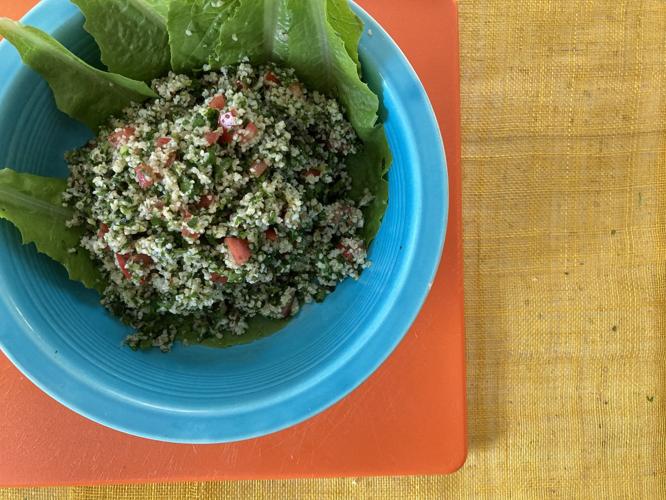More than 15 years ago, I learned to make tabbouleh from Nada Kattar, a Lebanese-American home cook living in Chicago and the mom of my good work buddy, Pierre. Over the phone, Nada schooled me, explaining in no uncertain terms that tabbouleh, an iconic dish of Middle Eastern small plates known as mezze, is an herb-forward salad, with bulgur as part of a supporting cast (and not the other way around).
As she dictated the recipe, I scribbled furiously knowing in my gut that this lady was talking serious tabbouleh business. I will never forget when she told me that everything in this salad revolves around the “parsley drinking the juice” of the other ingredients, and the most effective ways to quench the parsley are:
— Making sure that everything is as dry as possible; wet herbs result in a soggy and diluted tabbouleh.
— Finely chopping everything, perhaps more finely than you’re used to, and yes, that means a time commitment of at least 30 minutes just for chopping (but oh is it worth it).
— Layering the salad as if you were making a seven-layer dip and letting it rest in the refrigerator before seasoning.
— Mixing the salad by hand, as in your two hands; Nada insists that “the parsley is not drinking the juice if you use a spoon.”
So 15-plus years later, I still hear Nada’s voice in my head and make tabbouleh just as she taught me over the phone. I rarely say, “If it ain’t broke, don’t fix it,” but this is one of those rare exceptions. Her tabbouleh is that good. (You may find yourself eating directly from the bowl, too.)
Happy solstice!
Tabbouleh
Excerpted from "The Meat Lover’s Meatless Cookbook" by Kim O’Donnel.
Makes about 3 ½ cups.
Ingredients:
- ¾ cup fine- or medium-grain bulgur wheat
- 3 plum tomatoes
- 1 cup mint leaves
- 2 large bunches (about 3 ½ cups) flat-leaf parsley
- 6 scallions
- ½ cup lemon juice, from about 2 lemons
- ½ cup olive oil
- ½ teaspoon salt
- 1 head romaine lettuce, for garnish
Directions:
Everything must be as dry as possible. After you have washed all of the herbs, make sure to dry them well. It makes a dramatic difference to the end result.
In a medium bowl with some depth, cover the bulgur with water and soak for about 20 minutes. You’ll notice that the bulgur has absorbed the water and expanded. Add more water, just until covered, and continue soaking while you prep the rest of the ingredients.
Slice the tomatoes in half lengthwise, remove the seeds with your fingers or a teaspoon and finely chop. Place in a large bowl.
Keep the mint and parsley separate at all times. Wash each thorough, shake out the water and dry in a towel or salad spinner.
Pull the mint leaves from their stems. Chop finely and lay on top of the tomatoes.
Separate the parsley leaves and discard the stems (or save for your next batch of stock). Chop the leaves until very fine, so small they almost look like a puree. Layer on top of the mint.
Thoroughly drain the water from the bulgur, then spread on top of the herb layer like a blanket. Spread around with a spoon if needed. Cover and refrigerate for at least 30 minutes to chill and set up.
Meanwhile, prepare the scallions: Wash, dry and remove the roots. Using only the white and light green parts, chop very finely. Place in a small bowl and add the lemon juice.
When ready to serve, incorporate the scallion mixture into the bulgur mixture. With clean hands or with gloves on, mix thoroughly.
Stir in the oil and salt. Taste for seasoning and adjust as needed. Traditionally, tabbouleh is served with romaine leaves that can also be used as a garnish.
Serving partners are many and include: pita, feta, cucumbers, olives, grilled chicken, hummus, falafel, avocado.










 ERIN NEGLEY | Staff Writer
ERIN NEGLEY | Staff Writer
![Got garlic scapes? Make pesto [Stay-Put Cooking]](https://bloximages.newyork1.vip.townnews.com/lancasteronline.com/content/tncms/assets/v3/editorial/b/86/b86b7a00-abce-11ea-9f89-5772a8acad0d/5ee20a3f9cfc8.image.jpg?resize=150%2C111)
![How to make white bean salad from a Rancho Gordo bean club member [Stay-Put Cooking]](https://bloximages.newyork1.vip.townnews.com/lancasteronline.com/content/tncms/assets/v3/editorial/a/50/a50ba22e-b0c8-11ea-be19-bbce677c7453/5eea6182509b6.image.jpg?resize=150%2C113)


